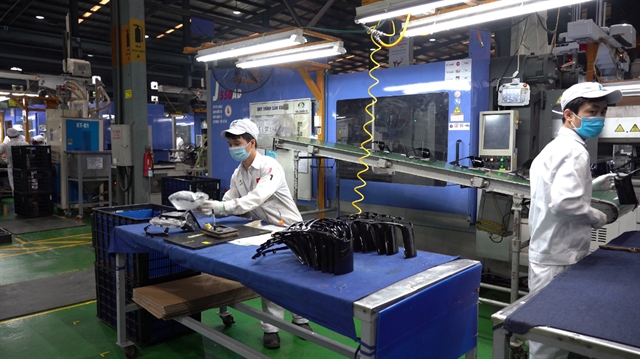 Economy
Economy


|
| Hà Nội Plastics Company. The plastics industry is set a goal to reduce the average energy consumption to 18-22 per cent by 2025 and 21-24 per cent by 2030. — Photo courtesy of Hà Nội Plastics Company. |
HÀ NỘI — In order to maintain a foothold in the global economy, companies in the domestic plastics industry are compelled to minimise their energy usage and lower their carbon emissions during production.
Huỳnh Thị Mỹ, general secretary of Việt Nam Plastics Association (VPA), said that electricity consumption in the rubber and plastic sector increased from 5.7 billion kWh in 2016 to 7.62 billion kWh in 2019.
With a large annual production output, the National Programme on Economical and Efficient Use of Energy for the 2019 - 2030 period (VNEEP3) has set a goal to reduce the average energy consumption of the plastics industry to 18-22 per cent by 2025 and 21-24 per cent by 2030.
To achieve the set targets as well as be in line with the industry's energy consumption and development trends, the Ministry of Industry and Trade has directed the implementation of many activities to support enterprises to save energy.
However, according to surveys conducted by VPA, compliance with regulations on the energy consumption of plastic enterprises is still limited. Specifically, enterprises having reports on energy consumption account for 50.56 per cent of surveyed enterprises.
The number of enterprises achieving energy consumption norms is about 38 per cent, while the number of enterprises having plans to improve energy consumption efficiency is 22.47 per cent of the surveyed enterprises.
Mỹ said that situation was due to a lack of information or knowledge about the circular on energy consumption norms in the plastic industry.
On the other hand, the plastic industry had products with diverse types, sizes and raw materials, leading to different energy consumption norms, especially in factories with many different product lines.
Plastic enterprises also faced difficulties in changing technology and implementing energy-saving measures, especially small and medium enterprises (SMEs). The enterprises lacked the equipment to collect data on energy consumption due to manufacturing many different products, she said.
According to the association, to implement low-carbon production, it is necessary to enhance the energy-use consciousness of consumers and to recycle waste in the direction of circular economy development.
In addition, the regulation of collecting fees on Extended Producer Responsibility (EPR) as stipulated in Article 54 of the Law on Environmental Protection, effective from January 1, 2024, is also expected to contribute to promoting the development of plastic recycling in this industry.
Mỹ also emphasised that the Government and international organisations needed to support plastic factories to increase the construction and installation of solar power systems to reduce energy consumption. Meanwhile, businesses needed investment to innovate technology.
She said that small and medium-sized enterprises made up 90 per cent of Việt Nam's plastic industry, but only accounted for about 30 per cent of the industry's revenue.
In the future, plastic businesses would need to prepare to decarbonise, and the mandatory requirements relating to this issue needed to be set by the State. If SMEs wanted to integrate into the world economy, they would need to have many changes, the VPA secretary general said.
She also said the Government should have specific policies to support the SMEs depending on their scale of production. Accordingly, the businesses would be supported with funds to invest in energy-saving equipment, and to organise training courses for staff to implement minimisation of energy consumption.
Mã Khải Hiền, director of the Energy Conservation Research and Development Centre (ENERTEAM), said that besides the investment and application of technology by enterprises, industries of cement, steel and plastic needed to have support from the Government and relevant agencies in setting up industry carbon emission norms and implementing technical guidance in reducing carbon emission.
In addition, it was necessary to promote green finance support for businesses to easily access and use decarbonisation technologies.
According to Hoàng Văn Tâm from the Department of Energy Saving and Sustainable Development under the Ministry of Industry and Trade, the target of an action plan on climate change adaptation to 2030, with a vision to 2025, is that the proportion of renewable energy sources in the total primary energy supply will reach about 15-20 per cent by 2030 and 25-30 per cent by 2045. Greenhouse gas emission from electricity production is equivalent to about 42 million tonnes of CO2 by 2050.
The action plan also sets a target on green growth by 2025 of promoting sustainable production and consumption models in industry and commerce to reduce by 5-8 per cent in the consumption of raw materials and fuel of manufacturing industries such as textiles, steel, plastic and chemicals.
Along with that, the use of fuel-saving and environmentally friendly products is promoted instead of plastic products, which are difficult to decompose. — VNS




